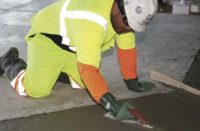Writing a standard for ASTM (American Society for Testing and Materials) is not a project that can be taken lightly.
ASTM International is one of the largest voluntary standards development organizations in the world — a trusted source for technical standards for materials, products, systems and services. Standards developed at ASTM are the work of more than 30,000 ASTM members. These technical experts represent producers, users, consumers, government and academia from more than 100 countries. Participation in ASTM International is open to all with a material interest, anywhere in the world. Anyone can attend any committee meeting, free of charge. However, to have a voting voice, you must join the committee.
When an ASTM standard for products and processes is published, it means the people responsible for writing the standards have gone over every aspect of the proposed standard. Every syllable has been carefully selected and back-up testing has been submitted. Then everyone on the committee votes on it. This creates a “safety zone,” so to speak, for a company that wants to use a particular product or process.
What an education I received when I joined Committee D33, “Protective Coating and Lining Work for Power Generation Facilities.” This Committee is responsible for Standard D4260, “Standard Practice for Liquid and Gelled Acid Etching of Concrete.” At the time in 2001, this Standard only addressed liquid acid. D4260 did not address gelled acids. Even the title of the standard was outdated. I joined D33 to have a voice and to get the standard rewritten.
I was told to get the wheel turning but not to expect the Standard to be rewritten in my lifetime. Well, that was not correct. Once they realized D4260 needed to be rewritten, it only took one year to actually turn the rewrite into a published standard.
When I joined Committee D33 to have them look at Standard D4260, I learned that there were several other standards that would also be involved. It is rare that a standard is a stand-alone one. So cross-referencing of the standards is verified.
I have a very high regard for the members of ASTM committees. They affect all industries, and it is understood and proven every time that a standard does not go out until it is written to everyone’s satisfaction.
While anyone from any industry can join any committee, it is most beneficial if they come with background knowledge specific to the standards they are responsible for. Therefore, almost all committee members come from the industry addressed by the standard. They all have full-time jobs, and are not compensated for their time on the committee, unless perhaps they are on the clock for their employer. There were approximately 50 members of D33. Within that committee there were approximately 15 subcommittees. Each one required a chairperson. There is always significant work done before and after the committee meets.
This work takes commitment from its members. Bruce Dullum of Carboline is a perfect example. This gentleman mentored me through the rewrite of D4260, and often I received after-hours e-mails from him that included correspondence from other members, also after hours. At this point I knew very little about the ASTM process, and the main focus of this committee was power generation facilities, which I knew even less about. Several of the committee members made sure I understood what was being voted on.
So, how does this play into the contractor’s life? Once a bid is awarded, you have to be in compliance with the specifications.
Most specs are almost boilerplate — an architect identifies a product line that works and he or she sticks with it, sometimes to the detriment of the project. For example, a certain coating that works better in high-moisture environments may be specified for a project in Arizona. You as a contractor should question the use of that product for this project. If it’s specified, you may feel your hands are tied. Not necessarily, however. Often the architect is open to discussing why this product is specified and may not even realize another product is available. Don’t be afraid to contact them to discuss options. The general contractor is often an even better call. They value educating subs and will often make every effort to make sure the standards are available to them.
There is a statement in D4260 that states, “Proper cross ventilation and chemical respirators shall be provided.” To be in compliance means to follow the standard in all aspects, not just the application process. This safety statement seems to be obvious. Nevertheless, a contractor who reads it might say, “Well, of course I need to provide ventilation, but this proves that all aspects, including safety, are taken into consideration and included in the standard.”
I have spoken with several contractors that are frustrated by architects. It seems architects don’t always understand products, and they will unknowingly specify inappropriate ones to get the blueprints approved. On the good side, contractors report that architects are usually open to discuss this. Frequently, architects will put a phrase such as “or other similar product” into their specs, which allows the contractor to make some intelligent changes. All the contractors that I’ve spoken with regarding this subject say the general contractors are usually the first person they call regarding standards that are unfamiliar to them.
Both the architect and the general contractor will have access to the ASTM standards needed for each project. However, visiting ASTM.org will give you access to all the standards ever written. Click on the “Standards” link and start browsing.
















